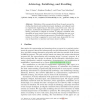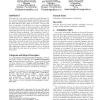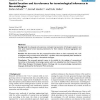40 search results - page 7 / 8 » Identifying traits with formal concept analysis |
ER
2007
Springer
14 years 13 days ago
2007
Springer
Abstract. Definitions of the concepts derived from the goal concept (including functional and nonfunctional goal, hardgoal, and softgoal) used in requirements engineering are discu...
EMSOFT
2006
Springer
14 years 6 days ago
2006
Springer
We report on a case study in which the model checker Uppaal is used to formally model parts of Zeroconf, a protocol for dynamic configuration of IPv4 link-local addresses that has...
JSW
2007
13 years 8 months ago
2007
— UML sequence diagrams focus on the interaction between different classes. For distributed real time transaction processing it is possible to end up with complex sequence diagra...
PVLDB
2010
13 years 3 months ago
2010
In this paper, we tackle the problem of efficient skycube computation. We introduce a novel approach significantly reducing domination tests for a given subspace and the number of...
BMCBI
2007
13 years 8 months ago
2007
Background: An adequate and expressive ontological representation of biological organisms and their parts requires formal reasoning mechanisms for their relations of physical aggr...



